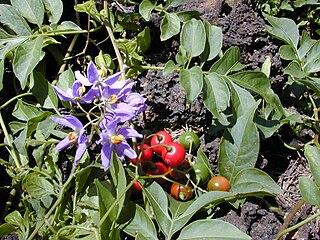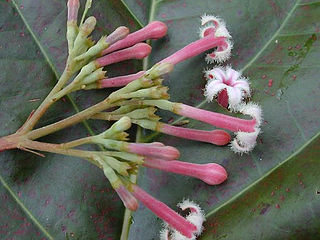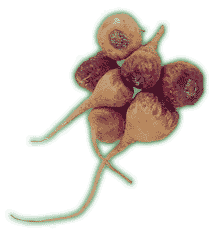
The potato is a root vegetable native to the Americas, a starchy tuber of the plant Solanum tuberosum, and the plant itself is a perennial in the nightshade family, Solanaceae.

Coca is any of the four cultivated plants in the family Erythroxylaceae, native to western South America. Coca is known for its psychoactive alkaloid, cocaine.

Quinoa is a flowering plant in the amaranth family. It is a herbaceous annual plant grown as a crop primarily for its edible seeds; the seeds are rich in protein, dietary fiber, B vitamins, and dietary minerals in amounts greater than in many grains. Quinoa is not a grass, but rather a pseudocereal botanically related to spinach and amaranth, and originated in the Andean region of northwestern South America. It was first used to feed livestock 5.2–7.0 thousand years ago, and for human consumption 3–4 thousand years ago in the Lake Titicaca basin of Peru and Bolivia.

Solanum is a large and diverse genus of flowering plants, which include three food crops of high economic importance, the potato, the tomato and the eggplant. It also contains the nightshades and horse nettles, as well as numerous plants cultivated for their ornamental flowers and fruit.

Cinchona is a genus of flowering plants in the family Rubiaceae containing at least 23 species of trees and shrubs. All are native to the tropical Andean forests of western South America. A few species are reportedly naturalized in Central America, Jamaica, French Polynesia, Sulawesi, Saint Helena in the South Atlantic, and São Tomé and Príncipe off the coast of tropical Africa, and others have been cultivated in India and Java, where they have formed hybrids.

The avocado, a tree likely originating from south central Mexico, is classified as a member of the flowering plant family Lauraceae. The fruit of the plant, also called an avocado, is botanically a large berry containing a single large seed.

Peru, officially the Republic of Peru, is a country in western South America. It is bordered in the north by Ecuador and Colombia, in the east by Brazil, in the southeast by Bolivia, in the south by Chile, and in the south and west by the Pacific Ocean. Peru is a megadiverse country with habitats ranging from the arid plains of the Pacific coastal region in the west to the peaks of the Andes mountains extending from the north to the southeast of the country to the tropical Amazon Basin rainforest in the east with the Amazon river. At 1.28 million km2, Peru is the 19th largest country in the world, and the third largest in South America.

Dieffenbachia is a genus of tropical flowering plants in the family Araceae. It is native to the New World Tropics from Mexico and the West Indies south to Argentina. Some species are widely cultivated as ornamental plants, especially as houseplants, and have become naturalized on a few tropical islands.

Alstroemeriaceae is a family of flowering plants, with 254 known species in four genera, almost entirely native to the Americas, from Central America to southern South America. One species of Luzuriaga occurs in New Zealand, and the genus Drymophila is endemic to south-eastern Australia.

Johann Jakob von Tschudi was a Swiss naturalist, explorer and diplomat.

Physalis peruviana, is a South American plant in the nightshade family (Solanaceae) commonly known as Cape gooseberry, goldenberry, and poha, in addition to numerous indigenous and regional names. The history of P. peruviana cultivation in South America can be traced to the Inca. It has been cultivated in England since the late 18th century, and in South Africa in the Cape of Good Hope since at least the start of the 19th century. Widely introduced in the 20th century, P. peruviana is cultivated or grows wild across the world in temperate and tropical regions.

Lepidium meyenii, known as maca or Peruvian ginseng, is an edible herbaceous biennial plant of the family Brassicaceae that is native to South America in the high Andes mountains of Peru. It was found exclusively at the Meseta de Bombón plateau close to Lake Junin in the late 1980s. It is grown for its fleshy hypocotyl that is fused with a taproot, which is typically dried, but may also be freshly cooked as a root vegetable. If it is dried, it may be further processed into a flour for baking or as a dietary supplement. It also has uses in traditional medicine. As a cash crop, it is primarily exported as a powder that may be raw, or processed further by the supplement industry: gelatinized or made into an extract.

Echinopsis peruviana, the Peruvian torch cactus, is a fast-growing columnar cactus native to the western slope of the Andes in Peru, between about 2,000–3,000 m (6,600–9,800 ft) above sea level.

Ilex guayusa is a species of tree of the holly genus, native to the Amazon Rainforest. One of three known caffeinated holly trees, the leaves of the guayusa tree are dried and brewed like a tea for their stimulative effects.

Billbergia is a genus of flowering plants in the family Bromeliaceae, subfamily Bromelioideae. The genus, named for the Swedish botanist, zoologist, and anatomist Gustaf Johan Billberg, is divided into two subgenera: Billbergia and Helicodea. They are native to forest and scrub, up to an altitude of 1,700 m (5,577 ft), in southern Mexico, the West Indies, Central America and South America, with many species endemic to Brazil.

Schinus molle is an evergreen tree that grows to 15 meters. It is native to the Peruvian Andes. The bright pink fruits of Schinus molle are often sold as "pink peppercorns" although S. molle is unrelated to true pepper. The word molle in Schinus molle comes from mulli, the Quechua word for the tree. The tree is host to the pepper-tree moth, Bombycomorpha bifascia.

Pitcairnia is a genus of plants in the family Bromeliaceae, subfamily Pitcairnioideae. It was named for Dr. William Pitcairn, Scottish physician and gardener (1711–1791). The genus Pitcairnia ranks as the second most prolific of the bromeliad family. They are most abundant in Colombia, Peru and Brazil, but can also be found in areas from Cuba and Mexico south to Argentina. One species, Pitcairnia feliciana is found in tropical West Africa and is the only member of the family Bromeliaceae not native to the Americas.
Werner Rauh was an internationally renowned German biologist, botanist and author.

Echinopsis pachanoi — known as San Pedro cactus — is a fast-growing columnar cactus native to the Andes Mountains at 2,000–3,000 m (6,600–9,800 ft) in altitude. It is found in Argentina, Bolivia, Chile, Ecuador and Peru, and it is cultivated in other parts of the world. Uses for it include traditional medicine and traditional veterinary medicine, and it is widely grown as an ornamental cactus. It has been used for healing and religious divination in the Andes Mountains region for over 3,000 years. It is sometimes confused with its close relative Echinopsis peruviana.
The Andean civilizations were complex societies of many cultures and peoples mainly developed in the river valleys of the coastal deserts of Peru. They stretched from the Andes of southern Colombia southward down the Andes to Chile and northwest Argentina. Archaeologists believe that Andean civilizations first developed on the narrow coastal plain of the Pacific Ocean. The Caral or Norte Chico civilization of Peru is the oldest known civilization in the Americas, dating back to 3200 BCE.

















